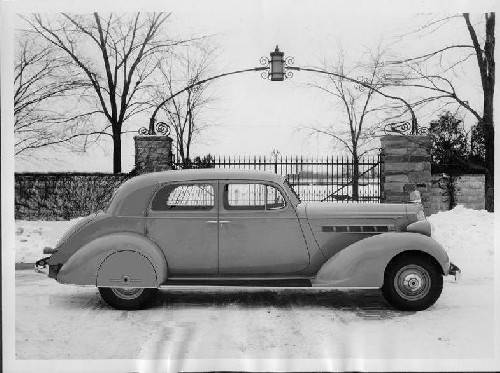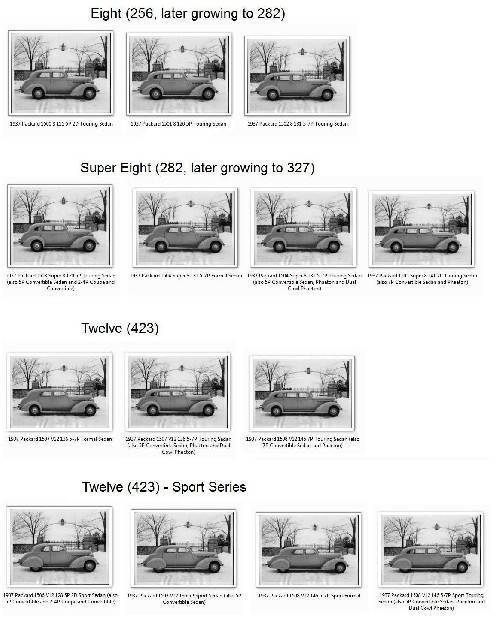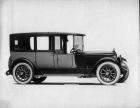|
'37 Junior-based V12 revisited
|
||||
|---|---|---|---|---|
|
Home away from home

|
We've hit this subject before but I wanted to explore from a slightly different perspective. What prompted was the first photo at the top of this site:
http://mmm.lib.msu.edu/results.php?search=1935+packard Clicking on the photo details one finds this caption on back: "8x10 black and white Packard Co. file photograph of a 1935 Packard left side view, plan sketch. Inscribed on photo back: design for Packard senior, model 120, twelfth series, 5-person special sport sedan, by Dietrich, Inc." The caption, if accurate, clearly points to the Twelfth Series, i.e. 1935, and the One Twenty chassis, and goes further by referring to it as a "senior." What it all sounds like is that Dietrich might have been suggesting to Packard to consider an upscale series based on the One Twenty, something that blended in modern styling cues from both the '33/34 Dietrich sport sedan and the '34 LeBaron sport phaeton. A breakthrough One Twenty-based Senior!? Hmm. I find it a fascinating suggestion given the context of the times. Consider the sales data confronting Packard in early 1935 when the planning for the 1937 model year commenced. The Twelfth series seniors had been selling since August '34 and tracking at around 7000 units for the year, or 1000 less than the abysmal 1934 number that resulted in losses for the company. Not exactly fabulous results for a brand new design and certainly no fault of the cars themselves. The market for traditional fine cars had simply not come back as hoped, even as other segments were on the up tick. At the same time the newly introduced One Twenty was selling like gangbusters, tracking at around 25,000 units for the year and held back only by its January intro and factory and new dealer ramp up. In light of these sales results, coupled with the favorable reception of the One Twenty and its incredible ride and handling qualities, and factoring in the Dietrich proposal for a senior One Twenty with up-to-minute styling, it seems that Packard had several clear paths to choose from as it pondered 1937, the choice of which would have long term ramifications. Packard's options appear to have included: - Maintain status quo, i.e. keep selling the One Twenty, Eight, Super Eight (or delete it) and Twelve and pour money into the Seniors (Safe-T-Flex, etc) in anticipation of a return of the fine car market. The challenge was that the return of this market looked decreasingly likely, not because wealth wasn't slowly returning to the nation but because these types of fine cars were of yesteryear design and manufacturing methods. - Do the above plus introduce a low priced 6 cylinder car to chase ever more volume, and continue to muddle along with the Senior's poor sales and profits, i.e. continue to live with "that g-d senior stuff." - Determine that the most pressing need was to get the Seniors back to healthy sales and profitability by getting to the root of what had become a multi-faceted problem: appearance, size, weight, technology, manufacturing and a changing luxury market. While the second option was the one that Packard ultimately chose, it's the last alternative that fascinates and leaves me wondering... did Packard consider it? Did they understand it? Looking beyond Dietrich's near plea that Packard modernize its designs, one has to consider Alvan Macauley's mindset and the actions he had taken 12 short years earlier when he cancelled the Twin Six and developed a new flagship, an Eight, that rolled down the same modern (for the time) assembly line as the lower priced Six. Alvan understood manufacturing and the need to be efficient. He always wanted Packard to be the Ford of luxury cars. By 1935 the Twelfth series seniors were fast becoming the old Twin Six. The One Twenty design and assembly line were the future. OK, enough said about the facts and theories surrounding it, let's explore option #3. What would such a new type of Dietrich-inspired senior based on the One Twenty look like? Here's an image that attempts to answer. It starts with the One Twenty touring sedan, the fundamental goal being to maintain rear seat legroom. Front axle moves forward 5 inches for a Senior appearance, front fenders and hood lengthen accordingly, windshield rakes more and becomes a two piece Vee, backlight rakes more for a sportier appearance, rear axle moves back 11 inches, front doors come from One Twenty coupe, rear doors from 138-CD 7 passenger sedan and with hinges located at same location relative to rear fender as One Twenty, and finally the trunk becomes integrated. From all this the wheelbase jumps from 120 to 136 inches, a good length for a mid to late-30s owner-driver Packard senior 5 passenger sedan. The image is somewhat like the CD-138 sport sedan that I floated last year but arguably better proportioned, having more hood and less of a cab-forward body. As for powertrain have always felt that a V12 based on the 282 Eight would have been the perfect replacement for the 320, 385 and 473. Displacement would have been 423 CID, power would have been 180 HP. Weight would have been around 4200 lbs or over 1000 lbs less than the big Twelve, which would have made the sport sedan the undisputed new boss of the road (or damn close to it!). Price would have been in the neighborhood of $2,000 - 2,300 which would have undercut the '37 Super Eight by several hundred dollars. And profitability would have soared, the new model rolling down the same line as the One Twenty. The ramifications of pursuing such a car would have altered life at Packard for many years to come. Amazing how seemingly small actions can do that. For starters, the 1937 line-up would have looked completely different, the updates contained in this car irresistibly finding their way into the entire One Twenty line, particularly the raked v-windshield and integrated trunk. Also easily within reach would have been a complete line of new Junior-based Seniors including a 7 passenger sedan and limo, thus retiring the traditional Seniors at the end of the 1936 model year. The money and manpower poured into the '37 Six and '37 and '38 Super Eight and Twelve would have instead gone towards perfecting this vital new series, and improving the One Twenty's appearance in the process. The ramifications may well have continued. First, Packard may have concluded that its big investment in the '37s was worthy of a two year model run, thus pushing back the all-steel bodies to 1939. As a stop-gap the '37s might have received an all steel turret top mated to their wood composite bodies just as Cadillac had done for some of its '35 and '36 cars. Second, when the Cadillac Sixty Special hit the showooms in September 1937 and Packard quickly learned of the shockwave it sent through the industry (lessoned of course by the shockwave sent by Packard's own V12 sport sedan the year prior), Packard may well have reconsidered its 1939 all steel design. Were the cars low enough? Wide enough? Maybe not! This may have led to a last minute redesign that would have resulted in a more Clipper-like car for 1939 or 1940. Wow, imagine Packard in lock step with GM's 1940 C-bodies. The events of life contain countless turns and near turns, it boggles the mind if one spends too much time contemplating them!
Posted on: 2013/3/22 20:28
|
|||
|
||||
|
Re: '37 Junior-based V12 revisited
|
||||
|---|---|---|---|---|
|
Home away from home

|
Excellent Steve, now we've got the juices flowing. Once the sport sedan was completed it would have been straightforward to expand to a full line-up that retired the old Seniors. Have attached what turned out to be an easy cut/paste showroom that shares one common rear roof/backlight shell. Has all the body styles typical of Packard in those years. Two new decklids - short and medium - would have been tooled to replace the former trunk hump design. The 2/4-pass coupe's long decklid and body style would have been retained. The sport sedan and other models in the new V12 "sport series" would have used the medium decklid exclusively, as shown.
I like your idea for a bigger Eight. Heck, let's call it the new Super Eight. If it wasn't ready for 1937 concurrent with the new V12, Packard could have simply used the 1935 256 inline 8 for the '37 Eight series (1500, 1501, 1502) and the 282 for the '37 Super Eight (1503-5). The new '37 V12 would become the 1506-8 series. The Super Eight would have used the Eight's (i.e. former One Twenty's) hood and front fenders and the interior of the '37 CD series. The new Twelve would have used an even richer interior. One thought about the C-bodies, Clipper and how all that history might have gone down differently had the scenario that I laid out above occurred. Packard would not have found itself caught in a pinch in 1941-42 where it only had the money, engineering resources and time to tool a Clipper sedan and fastback coupe. Instead the wide and low 1940 "almost Clipper" style that I mentioned would have received the full investment and engineering support that had gone into the 1938 all steel body program, the result being a showroom peppered with all the body styles of the day including limos and convertibles. This modern line-up would have served Packard admirably until 1948 when Reinhart's "51s" could have been unleashed 3 years earlier. My conclusion is that Packard, as it mapped out its forward planning in early 1935, went conservative with style, aggressively downmarket for growth instead of upmarket where they needed to regroup, and weren't quite ready to let go of their masterpiece - the wonderful but increasingly outdated traditional Seniors. At the same time Cadillac was in the final stages of releasing its 1936 60 Series and in the early stages of developing the related and stylistically avant garde LaSalle-turned-Sixty Special. The generation of cars that followed from each company dictated who would lead the luxury market over the next decade.
Posted on: 2013/3/25 14:47
|
|||
|
||||
|
Re: '37 Junior-based V12 revisited
|
||||
|---|---|---|---|---|
|
Home away from home

|
Hi
What a fine product line-up this is! Still covering all of their tradition styles as well as introducing new, progressive configurations. If these didn't appeal to the public, nothing would. To the discussion above: "My conclusion is that Packard, as it mapped out its forward planning in early 1935, went conservative with style, aggressively downmarket for growth instead of upmarket where they needed to regroup, and weren't quite ready to let go of their masterpiece - the wonderful but increasingly outdated traditional Seniors." Absolutely! They had more than one approach available to them to deal with the adverse affects of the Depression immediately and to build toward the more financially stable and prosperous future which included a new type of Senior series. The following, completely conjectural analysis may describe what took place in the boardroom discussions that lead to those decisions. The questions on the table were which of the options presented would be chosen. For you consideration and comment: One can image the discussions as they proceeded, Gilman and Christopher making the strongest argument for a '37 Six, given it would utilize a high percentage of existing tooling and the potential for volume was even greater than the current 120. Another board member (perhaps M. A. Cudlip), who's seen the Dietrich proposals, championed that avenue as a worthwhile alternative for developing a new type of Senior Packard into a potentially very profitable series, rather than going further down market into the rugged head-to-head fray against well-established, aggressively-priced Big Three makes. Gilman and Christopher grumble the potential volume wouldn't be nearly as great as a lower-priced Six, would require much more funding upfront for unique tooling, voiced solid opposition against the concept. Alvan and the old boys, holding their myopic, "the-market-will-turn-back-again-soon-to-our-Seniors-----restoring-our-profitable-'20's-market-position" mindset, listen politely then demur to support any further exploration of the Junior-based Senior proposal. Gilman and Christopher happily continue to hammer away at the advantages of their position for a lower-priced Six until there was agreement, or at least submission, all around the table. Although this is only suppositional, but I think its a fairly accurate portrayal of the management dynamics that lead to the decisions and the course they ultimately pursued. Your comments and perspectives sought. Steve
Posted on: 2013/3/27 10:18
|
|||
|
||||

 (68.89 KB)
(68.89 KB)








